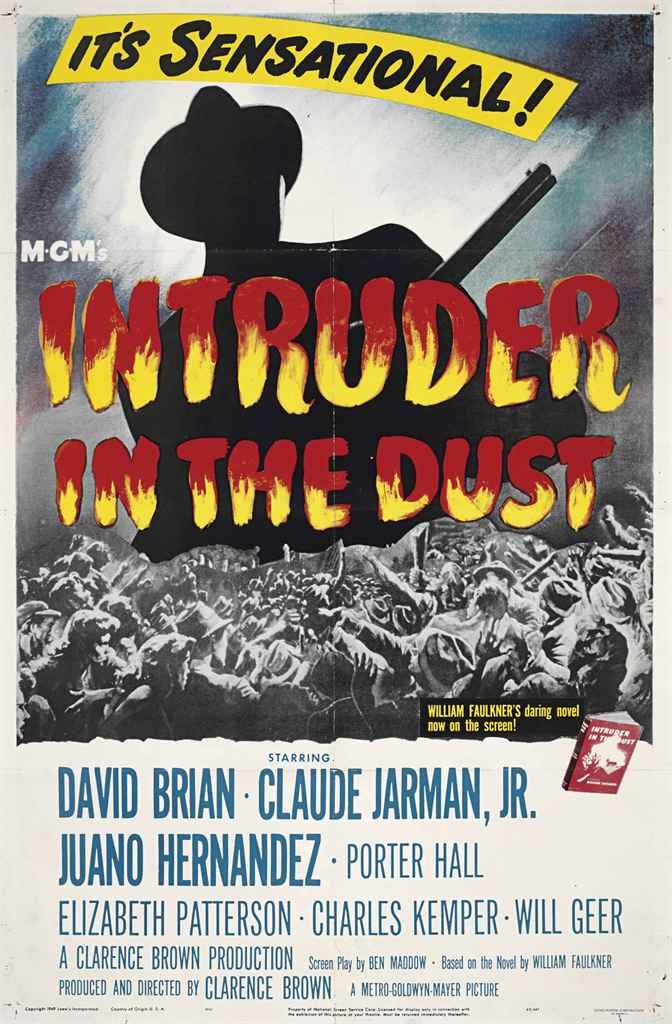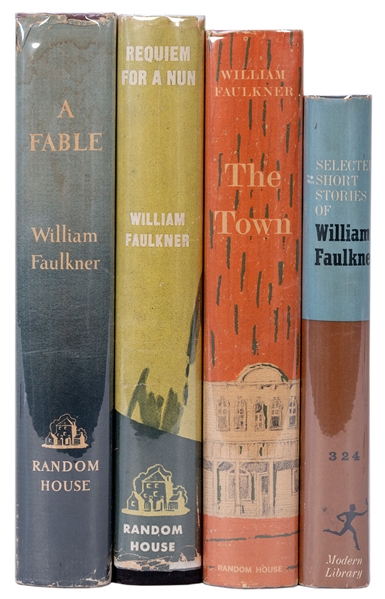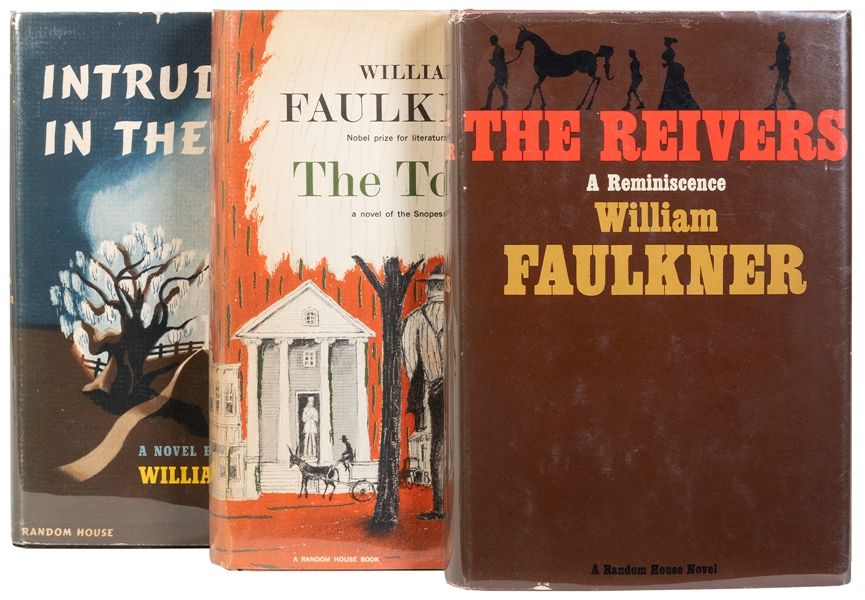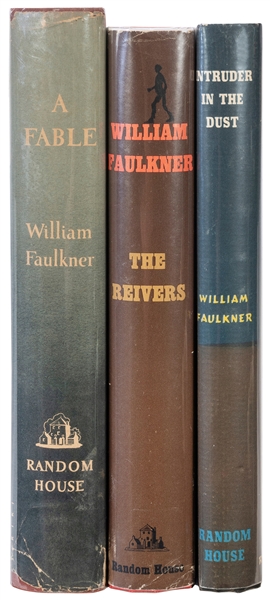FAULKNER, William (1897-1962). A group of 62 letters comprising HIS COMPLETE CORRESPONDENCE WITH ELSE JONSSON, containing: 10 Autograph Letters signed ("Bill"), 5 Autograph Letters, 15 Typed Letters signed (one "William Faulkner, most "Bill") and 32 Typed Letters (several with 1- to 4-line autograph postscripts); all to Else Jonsson in Stockholm, Sweden; various places (Paris, Rome, New York; Oxford, Mississippi; Beverly Hills, Cal.; Charlottesville, Va.), various dates from 15 December 1950 to 14 December 1960. Together 63 pages, small folio and smaller, the typed letters single-spaced, with original envelopes addressed in Faulkner's hand, with original stamps and postmarks . All in extremely fine condition. FAULKNER'S IMPASSIONED, POIGNANT AND RICHLY AUTOBIOGRAPHICAL LOVE-LETTERS TO ELSE JONSSON, LETTERS "NEARER LITERARY STANDARDS THAN ANYTHING HE WROTE TO ANYBODY EXCEPT HIS OWN MOTHER AND MALCOLM COWLEY" UNPUBLISHED OTHER THAN IN EXCERPTS, THEY CONSTITUTE "THE NEAREST APPROACH TO AUTOBIOGRAPHY WE HAVE IN FAULKNER'S HAND" (--M. Gresset) A rich and virtually unexplored trove of Faulkner letters. At the Nobel prize award ceremonies in Stockholm, Faulkner had met Else Jonsson, the young widow of Thorsten Jonsson, who had translated Hemingway, Steinbeck and Faulkner into Swedish. Else, fluent in English, was assigned to serve as a laison with Faulkner and soon, the bereaved widow and the lonely author became lovers. They had several later meetings in Paris, and began a remarkable correspondence that continued until the author's death. Faulkner's letters to Else--some of which are quite lengthy--are surprisingly unaffected and spontaneous, passionate and playful, at times frankly sexual, suffused with wistful melancholy at their forced separation and occasionally, tinged with jealousy and regret. (Unfortunately, we have only one side of their correspondence, since Faulkner destroyed Else's letters upon receipt, to keep their relationship secret.) The letters are especially significant, points out scholar Michel Gresset, because "they are written to an equal in maturity," someone with whom "Faulkner could drop whatever mask he felt it necessary to put on with his other, younger mistresses: he could be confidential , and in a way that involved his very writing...." (Michel Gresset, "A Public Man's Private Voice: Faulkner's Letters to Else Jonsson," in Faulkner: After the Nobel Prize , ed. Gresset, 1987, pp. 61-73. Fully 38 of the letters to Else Jonsson are entirely unpublished. Of the other 24, only very brief extracts from these long personal letters were furnished by Jonsson to Joseph Blotner and published in his edition of Faulkner's Selected Letters (New York, 1977). In most cases, it is now clear, Else supplied a carefully selected excerpt, usually in reference to his writing. The letters, read in their entirety are considerably more interesting the the excerpts suggest: richly textured with references not just to his writing -- and his increasing desire to be finished with writing forever (to "break the pencil," as he puts it). They offer colorful descriptions of his life, farming and horse-raising in Oxford, his travels, his health problems, the frustrations of new-found celebrity, the burden of his dysfunctional marriage, his strong sense of responsibility for his daughter, Jill, and, in the later letters, his fears for the growing conflict in the south over the Civil Rights movement (Faulkner's 12 June 1955 letter contains one of Faulkner's strongest personal statements on America's looming racial conflicts.) Gresset, who carefully studied Blotner's excerpts, concludes that the 10 letters written by Faulkner to Else from May through November 1951 provide "a perfect 'autobiographical' picture of Faulkner's activity, both physical and intellectual, during these six months..."; while in Faulkner's letter of 13 December 1956, "we read, or hear, as perfect a vignette of the aging Faulkner as we are likely to find anywhere
FAULKNER, William (1897-1962). A group of 62 letters comprising HIS COMPLETE CORRESPONDENCE WITH ELSE JONSSON, containing: 10 Autograph Letters signed ("Bill"), 5 Autograph Letters, 15 Typed Letters signed (one "William Faulkner, most "Bill") and 32 Typed Letters (several with 1- to 4-line autograph postscripts); all to Else Jonsson in Stockholm, Sweden; various places (Paris, Rome, New York; Oxford, Mississippi; Beverly Hills, Cal.; Charlottesville, Va.), various dates from 15 December 1950 to 14 December 1960. Together 63 pages, small folio and smaller, the typed letters single-spaced, with original envelopes addressed in Faulkner's hand, with original stamps and postmarks . All in extremely fine condition. FAULKNER'S IMPASSIONED, POIGNANT AND RICHLY AUTOBIOGRAPHICAL LOVE-LETTERS TO ELSE JONSSON, LETTERS "NEARER LITERARY STANDARDS THAN ANYTHING HE WROTE TO ANYBODY EXCEPT HIS OWN MOTHER AND MALCOLM COWLEY" UNPUBLISHED OTHER THAN IN EXCERPTS, THEY CONSTITUTE "THE NEAREST APPROACH TO AUTOBIOGRAPHY WE HAVE IN FAULKNER'S HAND" (--M. Gresset) A rich and virtually unexplored trove of Faulkner letters. At the Nobel prize award ceremonies in Stockholm, Faulkner had met Else Jonsson, the young widow of Thorsten Jonsson, who had translated Hemingway, Steinbeck and Faulkner into Swedish. Else, fluent in English, was assigned to serve as a laison with Faulkner and soon, the bereaved widow and the lonely author became lovers. They had several later meetings in Paris, and began a remarkable correspondence that continued until the author's death. Faulkner's letters to Else--some of which are quite lengthy--are surprisingly unaffected and spontaneous, passionate and playful, at times frankly sexual, suffused with wistful melancholy at their forced separation and occasionally, tinged with jealousy and regret. (Unfortunately, we have only one side of their correspondence, since Faulkner destroyed Else's letters upon receipt, to keep their relationship secret.) The letters are especially significant, points out scholar Michel Gresset, because "they are written to an equal in maturity," someone with whom "Faulkner could drop whatever mask he felt it necessary to put on with his other, younger mistresses: he could be confidential , and in a way that involved his very writing...." (Michel Gresset, "A Public Man's Private Voice: Faulkner's Letters to Else Jonsson," in Faulkner: After the Nobel Prize , ed. Gresset, 1987, pp. 61-73. Fully 38 of the letters to Else Jonsson are entirely unpublished. Of the other 24, only very brief extracts from these long personal letters were furnished by Jonsson to Joseph Blotner and published in his edition of Faulkner's Selected Letters (New York, 1977). In most cases, it is now clear, Else supplied a carefully selected excerpt, usually in reference to his writing. The letters, read in their entirety are considerably more interesting the the excerpts suggest: richly textured with references not just to his writing -- and his increasing desire to be finished with writing forever (to "break the pencil," as he puts it). They offer colorful descriptions of his life, farming and horse-raising in Oxford, his travels, his health problems, the frustrations of new-found celebrity, the burden of his dysfunctional marriage, his strong sense of responsibility for his daughter, Jill, and, in the later letters, his fears for the growing conflict in the south over the Civil Rights movement (Faulkner's 12 June 1955 letter contains one of Faulkner's strongest personal statements on America's looming racial conflicts.) Gresset, who carefully studied Blotner's excerpts, concludes that the 10 letters written by Faulkner to Else from May through November 1951 provide "a perfect 'autobiographical' picture of Faulkner's activity, both physical and intellectual, during these six months..."; while in Faulkner's letter of 13 December 1956, "we read, or hear, as perfect a vignette of the aging Faulkner as we are likely to find anywhere















Try LotSearch and its premium features for 7 days - without any costs!
Be notified automatically about new items in upcoming auctions.
Create an alert